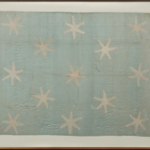The First National Flag and Origin of the Stars
We don’t know for sure about the origin of the stars, but some historians think that the use of stars on our flag was inspired by a poem published in the Massachusetts Spy on March 10th, 1774. The Spy was a heavily political weekly newspaper that was often contrary to the Royalist government. It originated in Boston, but as the revolution neared, it moved to Worcester Massachusetts for safety. The poem said:
‘ A ray of bright glory
Now beams from afar;
The American ensign
Now sparkles a star.’

It is thought that this poem led to the creation of a flag similar to the Colonial Banner of Rhode Island. It was white with a blue anchor with the word “Hope” in the main body, and a block of blue with 13 gold stars in the top left.
 At about the same time, George Washington was using a Headquarter Flag, sometimes known as the Commander-in-Chief standard. It was a blue flag with 13 stars.
At about the same time, George Washington was using a Headquarter Flag, sometimes known as the Commander-in-Chief standard. It was a blue flag with 13 stars.
At the time, most naval ships were flying the Grand Union Flag. It had red and white stripes for the body, and the upper left (called the canton) was the Union Jack. Once the revolutionary war was underway, the colonial navy wanted to do away with the Union Jack and the star field from Rhode Island’s flag replaced it.
Colors of the Flag
It’s noted that the red color in the flag symbolizes blood and stands for courage. The white is for purity and cleanness, and the blue stands for justice, perseverance, and vigilance. Stars were common in flags, symbolizing heavenly bodies and sovereignty.
Our current flag design, the Stars and Stripes, was adopted by Congress on June 14th, 1777. Still, most of the armies in the Revolutionary War carried their State flags through most of the war. It wasn’t until after the war that the idea of a national flag began to catch on.